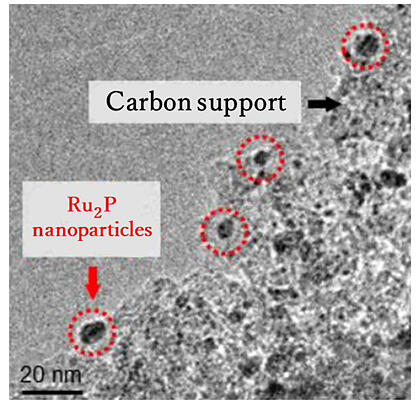Associate Professor Takato Mitsudome and Postgraduate Student Hiroya Ishikawa of the Graduate School of Engineering Science at Osaka University have developed ruthenium phosphide nanoparticles with high tolerance to sulfur, a catalytic poison. They found that the nanoparticles function as an efficient catalyst for reductive amination reactions that convert various carbonyl compounds containing sulfur atoms to amines. Their achievements were published in ACS Catalysis.

Provided by Osaka University
Reductive amination reactions, which convert carbonyl compounds to amines, are important in the chemical industry because they yield primary amines that are raw materials for pharmaceuticals, agrochemicals, dyes, synthetic resins, and functional materials. Conversion of carbonyl compounds that contain sulfur atoms to amines has been difficult because conventional catalysts require harsh reaction conditions with high hydrogen pressure to accelerate the reaction, and sulfur is a catalyst poison that significantly reduces catalytic activity. Catalyst poisons are atoms or molecules that reduce the activity, selectivity, durability, or other aspects of the performance of a catalyst. They adsorb on the catalyst surface and block the reaction site, preventing the catalyst from acting efficiently on the reactants.
Sulfur atoms and organosulfur compounds are known to be potent catalyst poisons, and they can significantly reduce catalytic activity even at trace levels. The research group found that ruthenium phosphide nanoparticles (Ru2P/C) with a diameter of approximately 5 nm act as solid catalysts possessing high activity and sulfur tolerance in reductive amination reactions. Catalysts known to promote reductive amination reactions (Pd/C) cannot convert carbonyl compounds containing sulfur atoms to amines. The developed catalyst has high sulfur tolerance and efficiently accelerates amination reactions. It can be used to convert various carbonyl compounds containing sulfur atoms to amines.
After the reaction, Ru2P/C can be separated and recovered from the reaction solution by centrifugation and can be reused without loss of activity. Since sulfur-containing amines are important compounds widely found in bulk pharmaceuticals and intermediates, the newly developed Ru2P/C is expected to contribute to the development of a new catalytic process for the production of sulfur-containing amines with high efficiency and low environmental impact.

(b) Reductive amination of sulfur-containing carbonyl compounds catalyzed by Ru2P/C.
Provided by Osaka University
Mitsudome said, "Our group is conducting research on the development of new catalytic functions using metal nanoparticles. In this study, we found that ruthenium phosphide nanoparticles efficiently accelerate reductive amination reactions of carbonyl compounds. We also found that the developed catalyst has high sulfur tolerance and is applicable to reductive amination reactions of carbonyl compounds containing sulfur, which is a catalyst poison. In the future, we will verify the effectiveness of this catalyst for various reactions that have been difficult to accelerate due to sulfur catalyst poisoning."
Journal Information
Publication: ACS Catalysis
Title: Highly Active and Sulfur-Tolerant Ruthenium Phosphide Catalyst for Efficient Reductive Amination of Carbonyl Compounds
DOI: 10.1021/acscatal.3c06179
This article has been translated by JST with permission from The Science News Ltd. (https://sci-news.co.jp/). Unauthorized reproduction of the article and photographs is prohibited.




